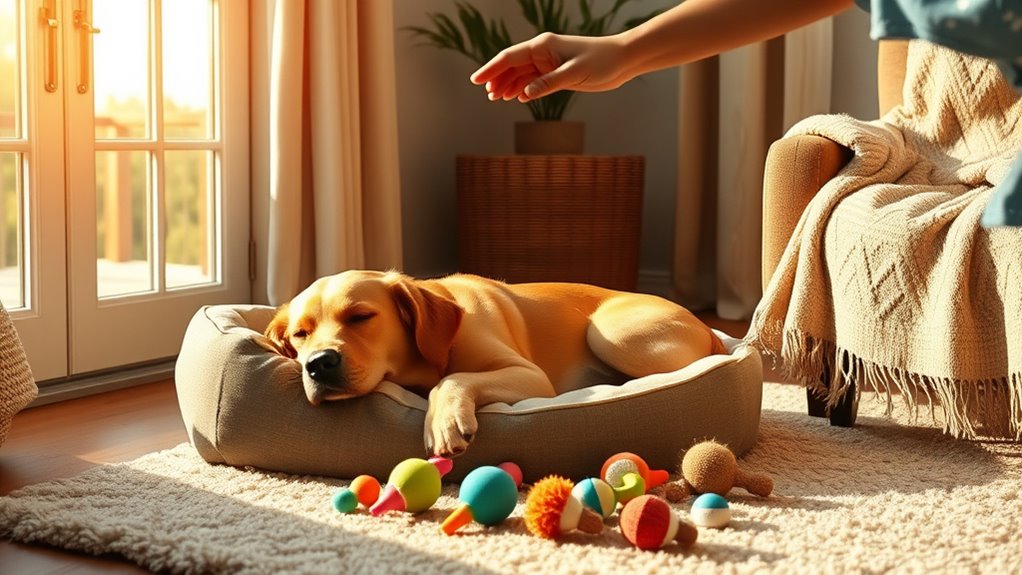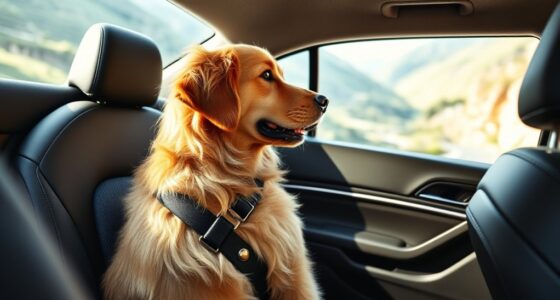Living with a blind dog calls for creating a safe, comfortable space by removing hazards and using consistent routines. Communicate clearly using verbal cues and gentle touch, and incorporate training to help them navigate. Enhance their quality of life by providing social interactions and mental stimulation, while also monitoring their health closely. Regular vet check-ups are essential for maintaining their well-being. To learn even more ways to enrich your dog’s life, keep exploring these tips and strategies.
Key Takeaways
- Create a safe environment by removing hazards and maintaining clear pathways to prevent injuries and enhance navigation for your blind dog.
- Use consistent verbal cues, touch signals, and scent markers to improve communication and help your dog navigate their surroundings effectively.
- Establish a daily routine for feeding and exercise to provide familiarity and reduce anxiety in your blind dog.
- Monitor your dog’s health with regular vet visits and watch for signs of stress or eye issues to ensure overall well-being.
- Encourage socialization and provide tactile and sensory experiences to enhance your dog’s quality of life and mental stimulation.
Creating a Safe Environment

Creating a safe environment for your blind dog is essential to ensure their well-being. Start by removing sharp objects and unstable furniture to prevent injuries.
Use corner protectors to soften edges and block access to hazardous areas like stairs with baby gates. Keep floors clear of clutter, reducing tripping hazards.
It’s crucial to maintain consistency in your dog’s surroundings, so keep furniture in the same places and stick to a daily routine for feeding and walking.
Incorporate sensory aids like textured mats or distinct scents to help your dog navigate. Approximately 1 in 10 dogs experience vision impairment as they age, so it’s important to be observant and proactive in creating a safe space for your pet.
Regularly inspect your home from your dog’s perspective to identify potential hazards.
Communication Strategies

Effective communication with your blind dog is vital for their comfort and understanding. Use consistent verbal cues, as your dog can hear and respond to specific commands. Incorporate physical touch; a gentle nudge on their shoulder can signal actions like “sit” or “down.” While they can’t see hand signals, combining them with verbal cues and touch creates a multi-sensory approach. Sensory impairments require unique approaches to training and interaction, emphasizing the importance of adapting your methods to fit their needs. Additionally, fostering a strong bond through unconditional love can enhance your dog’s well-being and confidence.
Effective communication is essential for your blind dog’s comfort; use consistent verbal cues for clarity.
Consider using vibrations from a collar for alerts. Scent markings on furniture can help them navigate their environment. Always practice positive reinforcement, rewarding them with treats or praise for desired actions. Be patient and repeat commands consistently to enhance understanding and learning.
With these strategies, you’ll foster a strong bond and improve your dog’s quality of life.
Training and Adaptation

While adapting to life with a blind dog can be challenging, the right training techniques can significantly enhance their quality of life.
Start with clicker training to mark desired behaviors and use positive reinforcement to build confidence. Teach basic commands like “sit,” “down,” and “come” using treats and verbal cues. Incorporate the name game to help your dog orient to your voice.
Maintain a consistent environment and use scents to mark furniture locations, aiding navigation. Scent mapping can also help your dog establish a familiar pathway, further reducing confusion. Monitor their behavior for signs of stress or aggression and be patient as they adapt.
Introduce commands for obstacle navigation, like “Careful!” and practice leash walking to help them avoid collisions. With time and consistency, your blind dog can thrive.
Enhancing Quality of Life
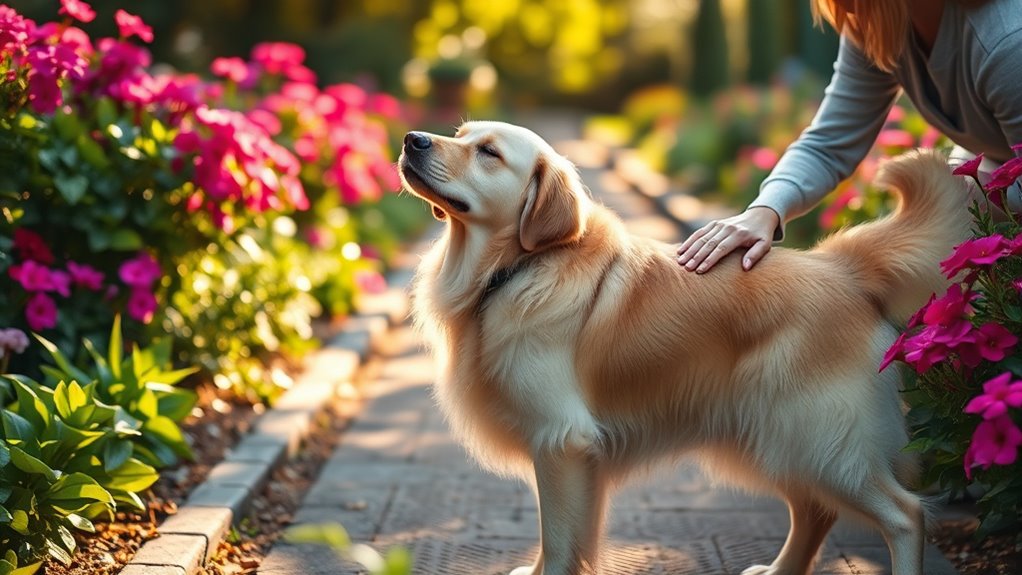
To enhance the quality of life for your blind dog, focus on making thoughtful adjustments in their environment and daily routine.
Regularly check your home for hazards, and keep furniture in the same place to ensure safety. Blind pets rely on memory to navigate their surroundings, so consistency is crucial. Encourage socialization with other pets and people, but do it in controlled settings.
Create safe outdoor spaces where your dog can explore freely. Engage their heightened senses with toys that make noise or have distinct scents.
Consider introducing a sighted companion pet for guidance. Show affection and play regularly to boost their emotional well-being.
Provide soft bedding for comfort, and maintain a positive attitude to help reduce stress.
These steps can significantly improve your dog’s quality of life.
Routine and Consistency

Creating a comfortable life for your blind dog goes hand in hand with establishing a consistent routine. Routine helps your dog feel secure and confident, reducing anxiety. Stick to regular feeding and exercise schedules, as this predictability allows your dog to anticipate daily activities.
Keep food, water, and bedding in the same locations to minimize confusion. Creating a familiar environment is crucial; avoid frequently changing furniture arrangements. Use textured rugs to help your dog navigate spaces safely. Incorporate consistent ambient sounds, like a TV or radio, to create comfort. Regular vet check-ups will also help monitor your dog’s overall health and detect any issues early.
Regularly train your dog with positive reinforcement using tactile and scent cues. This consistency builds trust and reinforces good behavior, making life easier for both of you.
Technology and Tools
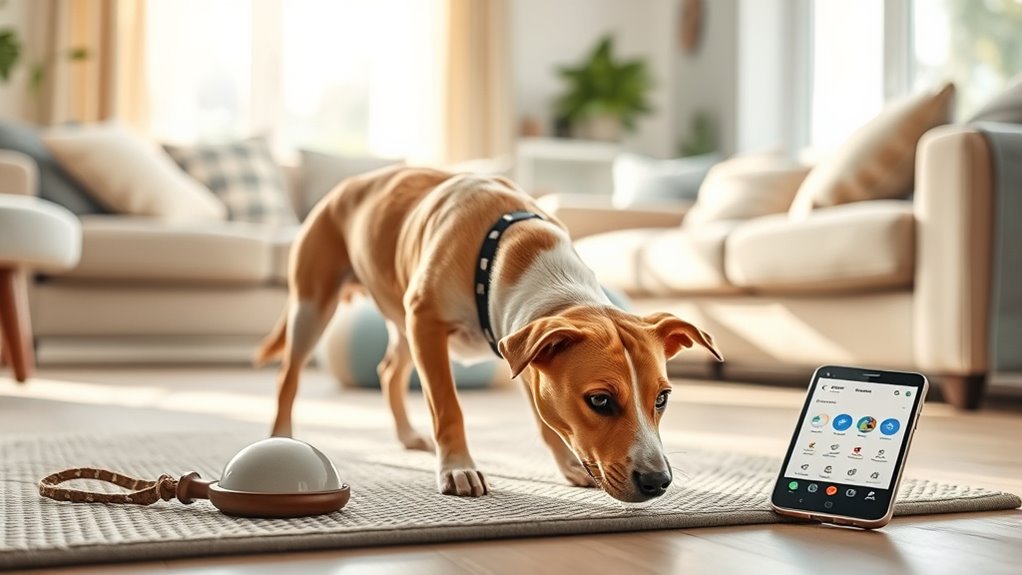
As you adapt to life with a blind dog, technology and tools can significantly enhance their mobility and safety.
Consider using a blind dog halo to prevent bumps into obstacles; it provides a lightweight harness with a circular ring.
Sound-emitting devices, like the Echo-Small, utilize echolocation to help your dog navigate both familiar and unfamiliar spaces.
GPS trackers are invaluable for adventurous outings, ensuring you can locate your dog if they wander.
Vibrating collars can aid in training by providing directional cues. Blind dog halos help prevent collisions with objects, enhancing your dog’s confidence while navigating.
Additionally, tactile maps and scent markings help your dog create a mental layout of your home.
With these tools, you can create a safer, more navigable environment for your blind furry friend.
Social Interactions and Engagement
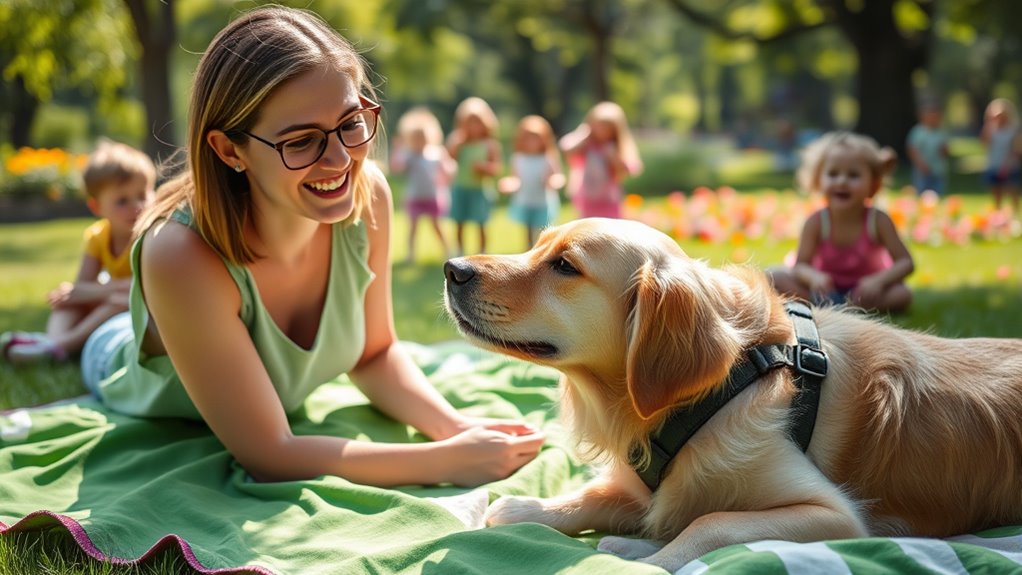
While adjusting to life with a blind dog, understanding their social interactions is crucial for fostering a sense of security and happiness.
Blind dogs rely on familiar scents to recognize people, so let them smell visitors before any contact. Use regular vocal cues to help them locate you around the home. Approach them gently and predictably to avoid startling them.
When interacting with other dogs, allow them to sniff first and supervise their meetings to prevent misunderstandings. Keep introductions calm and gradual, especially with unfamiliar dogs. Reduced anxiety is achieved through familiar routines and environments, which can help your blind dog feel more secure during social interactions.
If your blind dog shows fear or aggression, gradually expose them to new experiences and consider professional guidance. Positive reinforcement will build their confidence and enhance their overall happiness.
Outdoor Safety Considerations
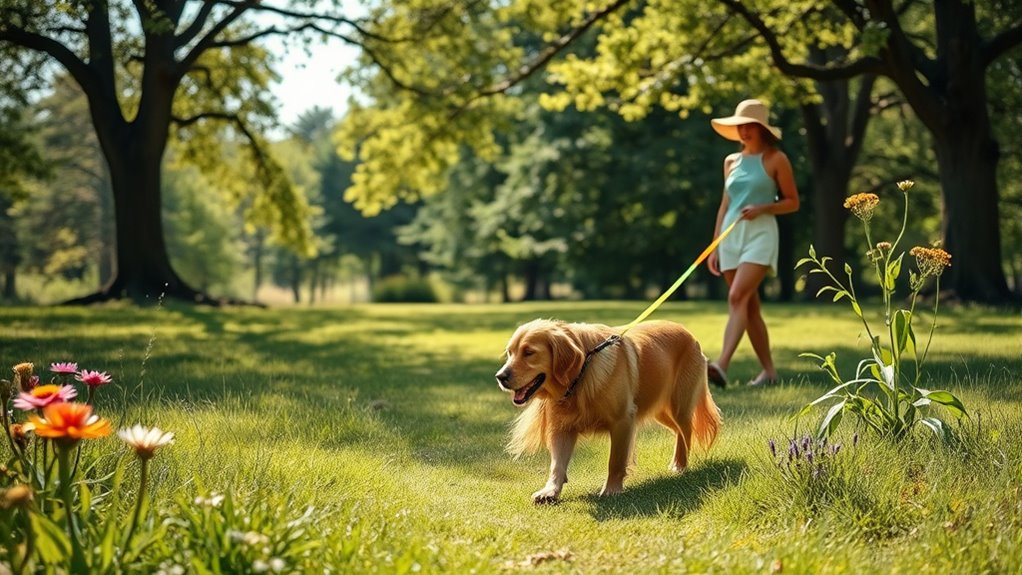
Ensuring your blind dog’s safety outdoors is essential for their well-being and your peace of mind. Start by installing a fence around pools or ponds to prevent accidental falls and removing debris from the yard. If your yard isn’t fenced, consider an invisible fence to keep them from straying. Use verbal cues like “step up” or “step down” near obstacles, and attach bells to other pets’ collars to help your dog navigate.
Additionally, training your dog with touch signals can enhance their ability to respond to commands and navigate their environment more effectively. Keep routes consistent and avoid rearranging outdoor furniture. Always supervise your dog near water and be cautious of potential hazards like traffic or sharp objects. A brightly colored harness makes them more visible, while gradual exposure to new environments helps reduce disorientation.
Health Monitoring and Veterinary Care
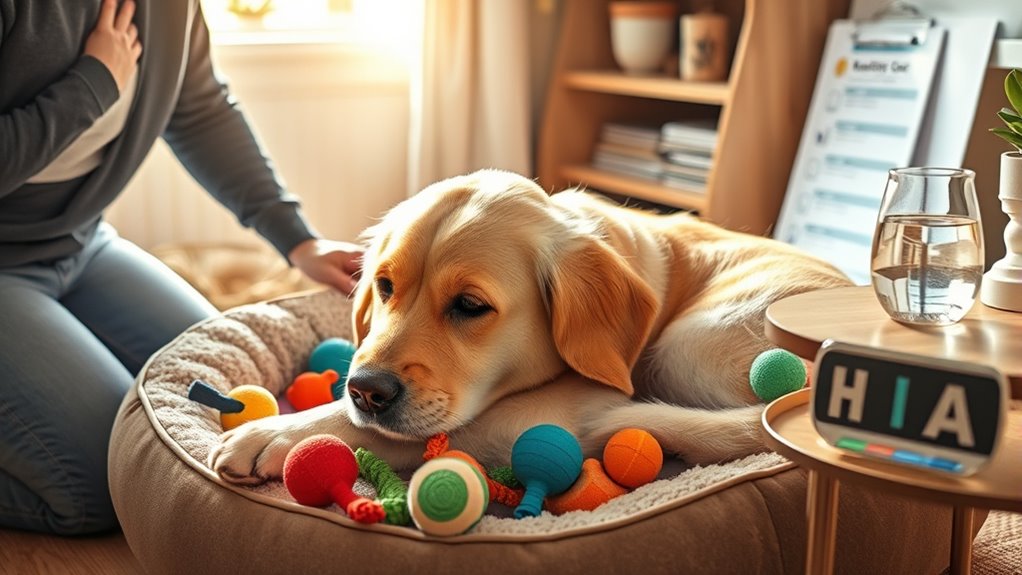
Regular health monitoring and veterinary care are crucial for your blind dog’s well-being. Schedule regular check-ups to keep an eye on eye health and catch issues like glaucoma or uveitis early. Watch for signs of eye infections, such as redness or discharge, and report any behavioral changes to your vet. Blood work and urinalysis can help identify systemic issues affecting your dog’s health. If cataracts cause the blindness, monitor for any progression. Utilize vision assessment tests and intraocular pressure tests during vet visits to evaluate conditions accurately. Regular veterinary exams can detect early eye problems and are crucial for maintaining eye health. Don’t hesitate to seek a specialist’s advice for complex issues. Your proactive approach to health monitoring ensures your dog remains comfortable and leads a fulfilling life.
Comfort and Relaxation Solutions

Creating a comfortable environment for your blind dog is essential to their overall well-being and happiness.
Maintain consistency by keeping furniture in the same spots, which reduces confusion. Remove hazards by blocking off dangerous areas with gates. Softening sharp edges and placing textured mats helps your dog navigate safely.
Use scent markers on furniture to aid their navigation, and provide tactile cues for recognition. Establish a designated rest area with familiar sounds, like a TV, to enhance relaxation. Dogs can lead happy lives with reduced eyesight with proper support.
Minimize stress by avoiding sudden changes and placing favorite toys in consistent locations. Engage your dog mentally with interactive toys and sensory experiences, while verbal cues and noise-makers guide them safely through their environment.
Frequently Asked Questions
How Can I Help My Blind Dog Navigate New Environments?
To help your blind dog navigate new environments, start by using consistent verbal cues like “step up” and “careful.”
Walk them on a leash, allowing you to guide them safely.
Create a familiar layout by keeping furniture in the same spots and introducing textured mats to signal important areas.
Encourage exploration with sound cues, like a bell, to help them locate you.
Always reward their correct responses to foster confidence and understanding.
What Should I Do if My Blind Dog Seems Anxious?
You might think anxiety only affects humans, but your blind dog can feel it too.
If your dog seems anxious, start by observing their behavior. Look for signs like pacing or excessive vocalization.
Create a consistent environment to help them feel more secure. Engage in mental stimulation through scent games, and consider calming supplements.
If needed, consult your vet or a behaviorist for tailored strategies to ease their anxiety and enhance their comfort.
Can Blind Dogs Play Fetch or Chase Toys?
Yes, blind dogs can definitely play fetch or chase toys! Use noisy toys with bells or squeaks to help them track the sound.
Keep the throws short to make retrieval easier. Engage their other senses by incorporating smells and sounds into play, like hiding treats.
You might also use auditory cues during training, guiding them with commands. Just ensure the play area is safe and free from obstacles to prevent accidents.
How Can I Tell if My Blind Dog Is in Pain?
To tell if your blind dog is in pain, watch for behavioral changes like increased agitation or withdrawal.
Look for physical signs such as licking specific areas or favoring a limb.
If your dog shows reduced interest in play or refuses food, that might indicate discomfort.
Use tactile cues like gentle massages to gauge reactions.
Regularly monitor their behavior and consult your vet for a thorough assessment to ensure their well-being.
What Are Some Signs of Aging in Blind Dogs?
As your blind dog ages, you might notice several signs.
They may become less active, show changes in appetite, or sleep more than usual.
You might observe increased anxiety or confusion in new environments, as they rely on their other senses more.
Look for behavioral changes, like increased vocalization or reluctance to move around.
Monitoring their health regularly with vet check-ups can help you catch any underlying issues early.
Conclusion
Caring for a blind dog is like painting a masterpiece; it requires patience, creativity, and a gentle touch. By nurturing their unique needs and crafting a safe haven, you’ll help them navigate the world with confidence. With every wag of their tail, you’ll see the beauty of their spirit shine through. Embrace the journey together, and watch as your bond deepens, transforming challenges into a symphony of love and understanding.

